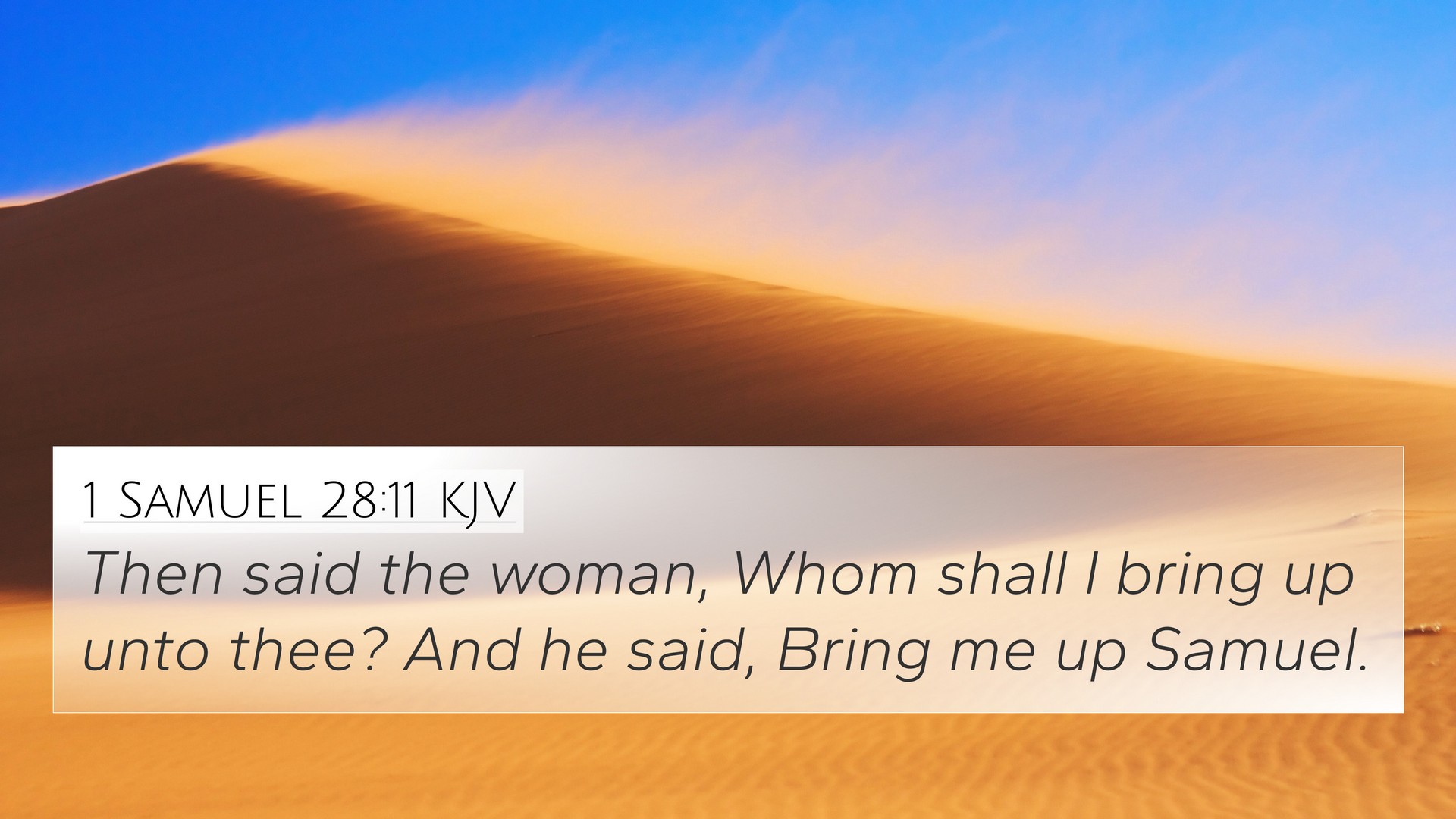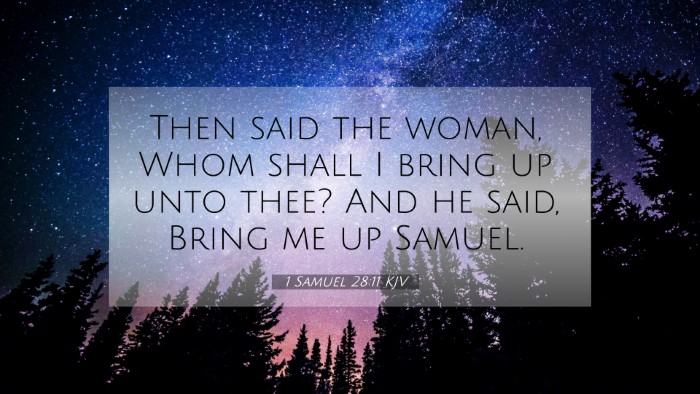Understanding 1 Samuel 28:11
1 Samuel 28:11 states, "Then said the woman, Whom shall I bring up unto thee? And he said, Bring me up Samuel." This verse provides a critical moment during King Saul's desperate search for guidance as he faced the Philistine army. It reflects not only his spiritual decline but also the extreme measures he takes in attempts to contact the deceased prophet Samuel.
Exegesis and Interpretation
This verse can be analyzed through several lenses, considering its historical and theological implications:
-
Historical Context:
Saul was in dire circumstances, overwhelmed by fear and uncertainty as his enemies approached. His consultation with a medium arose from his abandonment of God’s counsel, revealing a deep spiritual crisis.
-
Theological Implications:
The act of seeking out the dead contradicts the laws given in the Torah, emphasizing Saul's desperation and spiritual bankruptcy. His choice to turn to necromancy rather than returning to God showcases a critical turning point in his reign.
-
Character Analysis:
This moment illustrates Saul's tragic character arc, displaying a man who goes from God's anointed king to one who seeks illicit means for answers. It exemplifies the consequences of a heart turned away from God.
Cross-References and Connections
1 Samuel 28:11 is enriched by connections with various scripture passages, illustrating broader themes of communication with the divine and the consequences of disobedience:
- Deuteronomy 18:10-12: Discusses prohibitions against necromancy and witchcraft, highlighting the seriousness of Saul’s actions.
- 1 Samuel 15:23: "For rebellion is as the sin of witchcraft," reflecting on Saul's disobedience and its repercussions.
- 1 Chronicles 10:13-14: Provides a summary of Saul's demise due to his unfaithfulness to God.
- Isaiah 8:19: Warns against seeking counsel from the dead, emphasizing reliance on the Lord instead.
- New Testament Reference - Luke 16:31: Suggesting that those who do not heed the Scriptures will also disregard any supernatural signs.
- Hebrews 9:27: Discusses the finality of death, indicating that there is no consultation with the dead.
- Matthew 17:3-4: The Transfiguration, where Moses and Elijah appear, raises questions about divine communication beyond death yet within God’s ordained means.
Comparative Analysis of Related Verses
Through comparative Bible verse analysis, we find additional insights when examining the interactions between biblical characters facing similar tragic circumstances:
- Saul and King Manasseh: Both kings ended their reigns committing grave sins, with Saul consulting a medium and Manasseh engaging in idolatry.
- Elijah's Prophets of Baal - 1 Kings 18: Both narratives highlight the perils of turning away from God and seeking other means for divine knowledge.
- King Ahaz’s Idolatry - 2 Kings 16: Predictably, both kings' choices bring forth destructive consequences for their kingdoms.
Thematic Biblical Connections
1 Samuel 28:11 resonates with themes of desperation, guidance, and the consequences of spiritual disobedience:
- Desperation for Divine Guidance: Saul’s inquiry represents humanity's desire to seek answers when facing insurmountable challenges.
- Spiritual Decline: The act of consulting the dead illustrates a falling away from divine reliance.
- Consequences of Disobedience: Each biblical instance echoes the results of turning away from God, as shown throughout scripture.
Tools for Bible Cross-Referencing
When studying 1 Samuel 28:11 and its impact, one can utilize several tools and resources:
- Bible Concordance: A comprehensive directory that assists in finding related scripture efficiently.
- Bible Cross-Reference Guide: A resource to aid in quick identification of connected verses.
- Cross-Reference Bible Study: Methods to draw thematic parallels and understand deeper meanings between verses.
- Bible Reference Resources: Texts, commentaries, and guides to enrich your understanding of biblical passages.
Conclusion
The examination of 1 Samuel 28:11 embodies the complexity of Saul's character within the narrative of the Old Testament, representing not only an individual's tragic journey but also a larger testament of the necessity of faithfulness to God. Careful cross-referencing and thematic analysis with other biblically significant passages amplifies the understanding of Saul's choices and their profound implications for believers throughout history.


